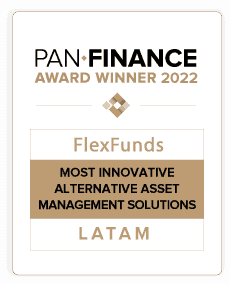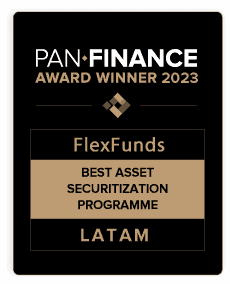- This is a general guide to understand what a hedge fund is and how one is typically created.
- Ideal for fund managers, advisors, and finance enthusiasts who want to learn how hedge funds are utilized.
- FlexFunds enables cost-efficient securitization of a hedge fund, facilitating access to international investors and expanding its distribution to private banking.
Within the financial industry, there are multiple collective investment vehicles that allow various savers and investors to place their money to protect and grow it.
Among the most popular are the so-called hedge funds, which, as their name suggests, focus on shielding participants from market fluctuations.
Below is a step-by-step guide to design and create a hedge fund, based on expert opinions, if you are an experienced advisor or portfolio manager.
What is a hedge fund?
A hedge fund is an alternative investment vehicle created specifically to generate positive returns regardless of the general market behavior, although this cannot always be achieved, evidently.
Characteristics of hedge funds
Hedge funds have some distinctive features worth mentioning:
- Greater freedom.
- Potentially higher returns.
Greater freedom
The main characteristic of hedge funds is that their management is free. Therefore, a hedge fund manager can invest in almost any asset and employ all types of strategies, whether bearish, bullish, volatility-based, etc.
Potentially higher returns
Being more flexible, a hedge fund can offer higher returns in exchange for greater risk. For example, a hedge fund could invest 100% of its portfolio in the shares of a single company. If the bet pays off, investors will earn a lot of money; if it goes wrong, they will lose everything.
Advantages and disadvantages of hedge funds
Like any investment vehicle, hedge funds have their own advantages:
- High returns.
- Hedging.
High returns
As mentioned earlier, due to greater management freedom, these funds can offer significant returns. In fact, Light Street Capital’s long/short fund ended 2024 with a return of 59.4%, compared to the S&P 500’s 23.3%. Meanwhile, Discovery Capital’s fund finished with a gain of 52%.
Hedging
Furthermore, hedge funds often do not aim to generate a return superior to a specific index during bullish trends but rather try to cushion declines in bearish markets.
According to consultancy Aurum, the hedge fund sector fell by 2.4% during 2022, a year in which the S&P 500 retreated more than 18%.
Nevertheless, these collective investment vehicles are not without some drawbacks:
- Limited regulation.
- High fees.
- Low liquidity.
Limited regulation
Not all countries worldwide have a regulatory framework that accommodates hedge funds or allows them to operate freely as in leading markets like the United States. For high-net-worth investors interested in these funds, this is a significant downside.
High fees
Additionally, since these funds require highly active management and sophisticated financial asset operations, fees tend to be higher. Moreover, in many cases, there is an extra cost for good performance, which can limit the final profit.
Low liquidity
And just like many real estate funds, hedge funds often have low liquidity. This means that shares cannot be redeemed overnight as with exchange-traded funds or more conventional mutual funds.
Hedge fund vs. mutual fund
It is very important to learn to differentiate a hedge fund from a mutual fund. As mentioned earlier, hedge funds have fewer limitations and can invest in multiple assets, liquid or illiquid, depending on the management team’s decision.
In contrast, a conventional mutual fund must follow a series of very strict rules created to protect the investor, usually retail.
Continuing with the previous example, a conventional fund could not invest 100% in a single asset because it would lack diversification and be very risky.
Another difference between a hedge fund and a mutual fund is that hedge funds are usually intended for large institutional investors or high-net-worth individuals.
Meanwhile, traditional mutual funds are generally available to all types of market participants, regardless of their capital and/or knowledge.
How to create a hedge fund step by step
If you are an experienced advisor or portfolio manager and wish to take a new step within the financial industry, then you should know how to create a hedge fund step by step.
Step 1: Acquire the necessary knowledge
Creating a hedge fund is not a simple task. Even if you master the main financial skills and have a long track record in the field, you must adequately inform yourself about how to create an investment vehicle of these characteristics.
Due to the complexity of creating a hedge fund, it is necessary to learn about each of its legal, operational, and financial aspects.
Step 2: Choose an operational strategy
After acquiring the necessary knowledge, you need to choose the operational strategy to apply when creating a hedge fund. Although there are many, and some can be complementary, three stand out:
- Neutral strategy: A hedge fund of this type invests in a series of assets with bullish potential and shorts those with bearish potential, through short selling and/or financial derivatives.
- Covered capital strategy: The goal here is to protect part of the portfolio by shorting only a portion of it. Instead of seeking near neutrality as in the previous strategy, this case has an underlying bullish view.
- Macro strategy: Macro strategy hedge funds invest following major economic movements globally or in a particular economy. In some cases, financial derivatives are used to further capitalize on upward trends.
It is important to define whether the hedge fund’s strategy will be neutral, covered capital, or macro to know which assets will be traded, in what quantity, and how.
Step 3: Contact a legal advisory team
Once you have decided what type of hedge fund to create and know how to manage and launch it, it is advisable to contact a legal advisory team to operate freely within the legal framework. After all, your goal will be to manage third-party money.
A legal consulting team will allow you to develop the collective investment vehicle according to current regulatory parameters.
Step 4: Learn to attract clients
If you have a long track record in the market as an advisor or portfolio manager, then you likely have an extensive network of contacts and potential clients. However, in today’s times, you must learn to attract new users through digital marketing strategies and/or collaborations with large investment platforms.
Being a large, ambitious, and professional project, communication and advertising should be handled by experts in the field, so you must ensure to hire marketing specialists.
Without clients, the hedge fund will not thrive, so you need to learn to attract an audience through digital and conventional strategies.
Can a feeder optimize the distribution of a hedge fund?
FlexFunds’ “FlexFeeder” or feeder fund is a type of investment fund that concentrates most of its assets in another main hedge fund.
It often optimizes the distribution of a hedge fund by simplifying regulatory compliance in various jurisdictions, which helps reach markets where direct distribution would be more complex.
Additionally, FlexFunds’ FlexFeeder can offer a more familiar investment structure for certain individual and institutional investors, expanding the reach and investor base of the main hedge fund.
Why it is important to securitize a hedge fund
After creating your hedge fund, it is important to consider its securitization to increase its distribution. Basically, this process involves converting an asset or group of assets, liquid or illiquid, into an exchange-traded product (ETP).
Through our FlexFeeder, you can securitize your existing hedge fund, easily expanding the base of international investors who can subscribe to your fund.
By converting hedge funds into financial assets with their own ISIN codes, investors could buy and sell them through their own brokerage accounts, as if they were an exchange-traded fund.
To securitize your hedge fund, do not hesitate to read our guide on how to do it practically and easily in just five steps, and if you wish to start the securitization process of your existing fund, feel free to contact us.
Sources:
- https://www.reuters.com/markets/hedge-funds-deliver-double-digit-returns-2024-2025-01-02/
- https://www.aurum.com/hedge-fund-data/hedge-fund-industry-deep-dive/hedge-fund-industry-deep-dive-full-year-2022/







